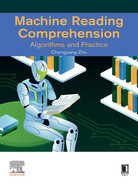Table of Contents
Chapter 1. Introduction to machine reading comprehension
1.1 The machine reading comprehension task
1.2 Natural language processing
1.4 Evaluation of machine reading comprehension
1.5 Machine reading comprehension datasets
1.6 How to make an machine reading comprehension dataset
Chapter 2. The basics of natural language processing
2.2 The cornerstone of natural language processing: word vectors
Chapter 3. Deep learning in natural language processing
3.1 From word vector to text vector
3.2 Answer multiple-choice questions: natural language understanding
3.3 Write an article: natural language generation
Chapter 4. Architecture of machine reading comprehension models
4.1 General architecture of machine reading comprehension models
Chapter 5. Common machine reading comprehension models
5.1 Bidirectional attention flow model
5.4 Essential-term-aware retriever–reader
Chapter 6. Pretrained language models
6.1 Pretrained models and transfer learning
6.2 Translation-based pretrained language model: CoVe
6.3 Pretrained language model ELMo
6.4 The generative pretraining language model: generative pre-training (GPT)
Chapter 7. Code analysis of the SDNet model
7.1 Multiturn conversational machine reading comprehension model: SDNet
Chapter 8. Applications and future of machine reading comprehension
8.1 Intelligent customer service
Appendix A. Machine learning basics
A.3 Generalization and overfitting
Appendix B. Deep learning basics
B.2 Common types of neural network in deep learning
